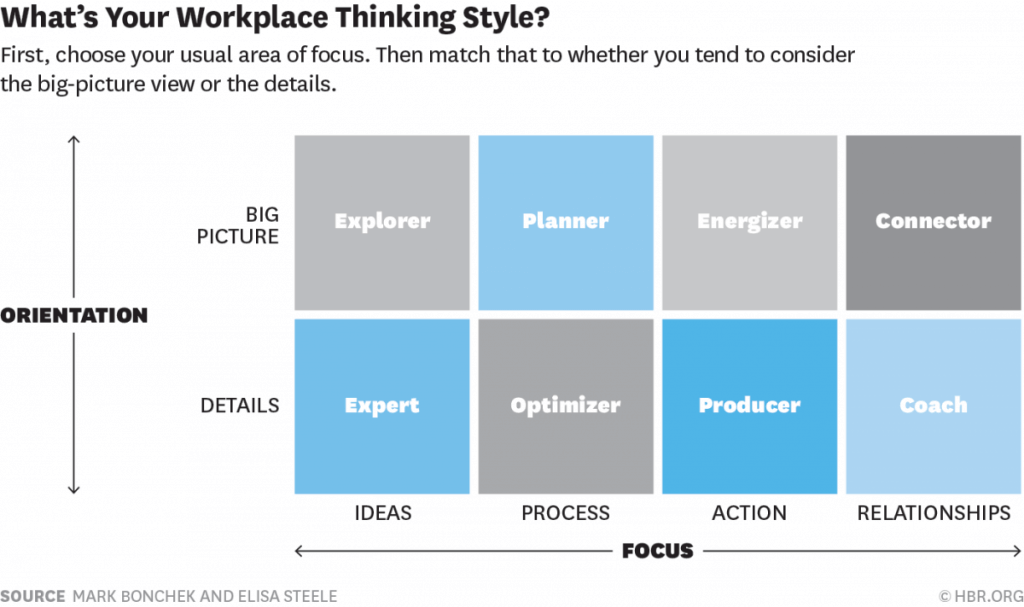Most of Business Analysis is about communication & collaboration. I even used to tell my students that our job was 80% communication / 20% analysis! This involves a lot of soft skills in order to be able to identify the best ways to interact with our business & IT stakeholders. This knowledge of your stakeholders is critical if you want to tailor your BA approach and optimize your work.
One of the easiest ways to improve your knowledge about your stakeholders is to use the formal organizational chart and the informal one. In some organizations, managers are also performing personality/behavior/influence tests to help their employees to better know each other and improve the performance of their team. However, there’s no easy way to assess how others think and what part of their work motivates them.
A new model attempts to solve this problem. Let’s learn more about the Workplace Thinking Styles, and what they mean for Business Analysts.
What kind of thinker are you?
How many times did you wonder how your work would be easier if you knew how your stakeholders were thinking? I discovered a part of the answer to this question in a recent article I read in the Harvard Business Review.
Through trials and errors, the authors of the article identified 2 main dimensions that together “would help people connect, communicate, and collaborate based on how they think”.
- Focus is where you usually tend to pay the most attention to when you work: ideas, processes, actions or relationships.
- Orientation is whether you think first of details or the big picture (ie micro vs macro thinking).
Knowing where you are located on these two axes then helps you to identify your Workplace Thinking Style. As per the HBR article:

On the big picture / macro orientation (taken from the HBR article):
- Explorer thinking is about generating creative ideas.
- Planner thinking is about designing effective systems.
- Energizer thinking is about mobilizing people into action.
- Connector thinking is about building and strengthening relationships.
On the details / micro orientation (taken from the HBR article):
- Expert thinking is about achieving objectivity and insight.
- Optimizer thinking is about improving productivity and efficiency.
- Producer thinking is about achieving completion and momentum.
- Coach thinking is about cultivating people and potential.
These thinking styles can be used to assess your interactions with other people, but also your own work as a BA. Let’s see how.
How to use Thinking Styles to improve collaboration with your stakeholders
Thinking Styles can be used to improve many aspects of your collaboration with your stakeholders. By looking to achieve a better balance between every style of thinker, you will be more confident that every aspect of a situation has been covered thoroughly. And even if you can’t find every type of thinker among your stakeholders, being aware of your “thinking weaknesses” will help you to mitigate their effects.
Using the Orientation Axis
For example, working with stakeholders oriented toward the big picture might be useful at the beginning of a project to identify objectives & broader requirements. However, they might become quickly overwhelmed when you’ll work on more detailed functional requirements.
Acknowledging this at the right moment will be a key success factor for your BA activities, and will allow you to work with the right people. It will also help you to focus your communication & deliverables accordingly (because reviewing a list of functional requirements isn’t a great activity for all your stakeholders)!
Using the Focus Axis
The same thing would be true along the focus axis. For example, having too many stakeholders oriented toward idea creation would make it difficult to identify the most promising ones. However, including process-oriented stakeholders would help you to evaluate how realistic are these ideas and add an interesting value to the process.
Moreover, relationships-oriented stakeholders could bring an interesting point of view about their effects on people in the organization. And action-oriented people could help achieving an implementation plan to bring those ideas to life.
In the end, the Thinking Styles are a great strategy to add to your toolbox when planning your Business Analysis activities and identifying the stakeholders to involve at each stage of your approach.
How to use Thinking Styles to improve yourself as a BA
Acknowledging your own thinking style is a great way to identify opportunities to improve yourself, or at least identify potential pitfalls in your own work.
If we look at myself as a BA, I’m landing somewhere between the Expert (micro / ideas) and the Optimizer (micro / processes) profiles. This often leads me to analysis paralysis, making me blind about my progress toward the team’s goal (because my BA deliverables need to be perfect) or deaf to my stakeholders’ comments.
In order to prevent these situations from happening, I usually try to identify collaborators who have a stronger focus on the action and relationships dimensions. This can be one of my clients, another BA or a project manager who can help me to have a more balanced Business Analysis approach.
Mapping the Thinking Styles of the BA community
Wondering if you’re the only Business Analyst with that weird Thinking Style? I set up a quick experiment to map in real-time the thinking styles of the BA community. Follow the step below to help your fellows and find out where you stand!
Based on this article, fill the survey with your own thinking style.
(all answers are completely anonymous)
Check the results in real-time and see how you compare to other BAs!
Can’t wait for the final results?
I’m sure they will reveal a lot about our community! If you want to get an update on this experiment (and much more!), don’t forget to sign-up for my newsletter below!





